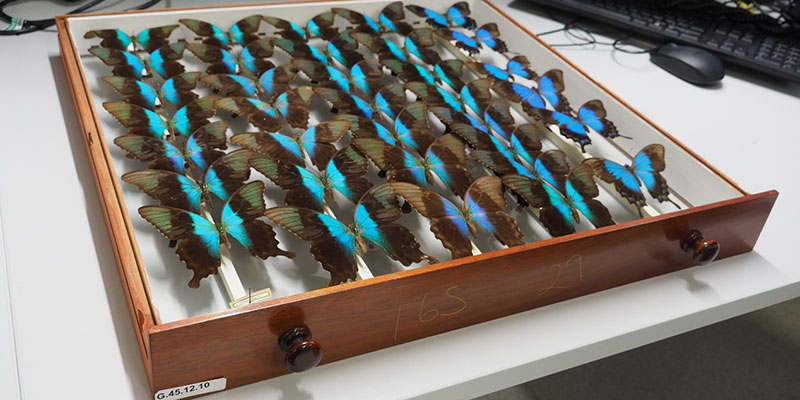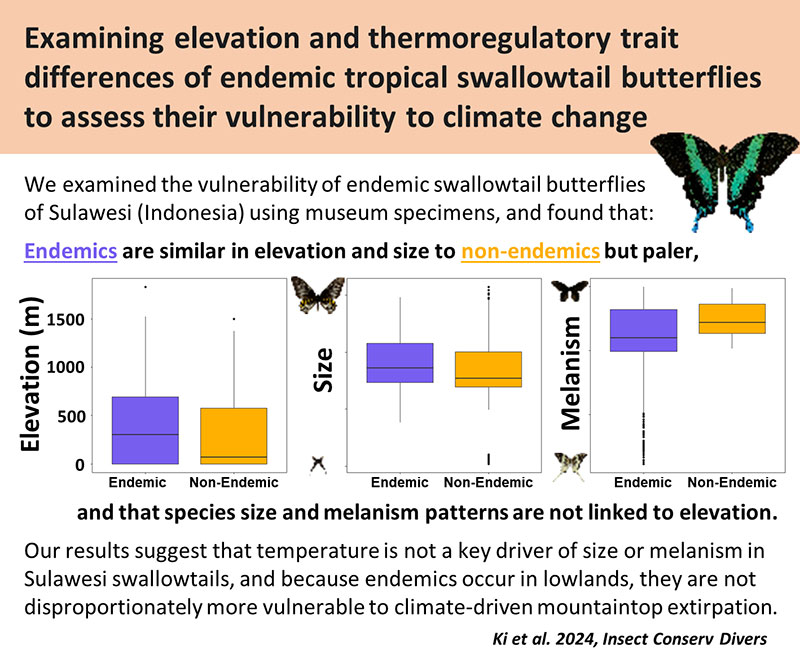Do endemic butterflies differ from non-endemic butterflies in elevation and thermoregulatory traits?
Climate change and land-use change are threatening biodiversity globally.

Tropical biodiversity might be more vulnerable, because current rates of forest loss are high and because tropical species are often adapted to living in a more stable environment (eg a narrower range of temperatures). For her PhD, Tiff Ki focuses on the butterflies of Sulawesi (Indonesia) to look at questions about tropical biodiversity and its change across time.
I use the large number of historic specimens held in natural history collections to answer these questions. In this article, I wanted to talk about the work from my first PhD Chapter, which has just been published.
In the tropics (and particularly in Sulawesi), there are lots of species that are only found in one place in the entire world. These endemic species often live at higher elevations and on mountain tops due to past ecological and evolutionary processes. Being already at mountain tops may place them at greater risk of extinction, because one of the key ways that species can respond to warming is by shifting to cooler locations, and in the tropics, this mostly means moving uphill.
At the same time, endemic species often have lived for a long time at their unique locations and may have faced a wider range of temperatures than they experience today, such as during warmer interglacials. This may have allowed them to develop adaptations to improve their thermoregulatory ability, which might allow them to better cope with continued warming. Body size and melanism (proportion of body that is black) are traits that are closely linked with thermoregulation. In this paper, we looked at whether endemic and non-endemic species differed in elevation, body size and melanism.
We analysed 1042 butterfly specimens held at the Natural History Museum (London, UK) and Zoologische Staatssammlung München (Munich, Germany). This involved: 1) taking high resolution photos of the butterfly specimens with their labels in the collections; 2) cataloguing data from these photos on the location, date, collector and other associated information from the specimen labels; and 3) measuring the forewing length and melanism of each specimen from the images.

Steps taken to analyse the butterfly specimens. 1 - Take a photo of the specimen with its labels; 2 - Catalogue the specimen data; 3 - Measure the forewing length and melanism
Surprisingly, we found that endemic species occupied similar elevations to non-endemic species. This suggests that endemics are not disproportionately vulnerable to mountain top extinction. But it is important to note that all montane species are at risk from climate-driven mountain top extinction, and that, in the tropics, rates of lowland forest conversion are still high, and this threatens all lowland species.
We found no differences in size between endemic butterflies and non-endemic butterflies, but found that endemics were less melanised than non-endemics. We also found that there was no relationship between elevation (a proxy for temperature) and either body size or melanism. Together, this suggests that temperature is unlikely to be the key factor affecting body size and melanism, and there is no evidence for endemic butterflies having evolutionary adaptations to climate change based on these morphological traits.
We also found that the melanism on the butterflies was concentrated on the outer edges of the butterfly wings, which also suggests thermoregulation is not the key purpose of the melanism, and other possible roles for the melanism could be to increase wing structural strength, to protect from pathogen or for improved sexual signalling.

Graphical Abstract for Published Article
Related links
- Learn more about Tiff Ki's research.
Related links
- Learn more about Tiff Ki's research.